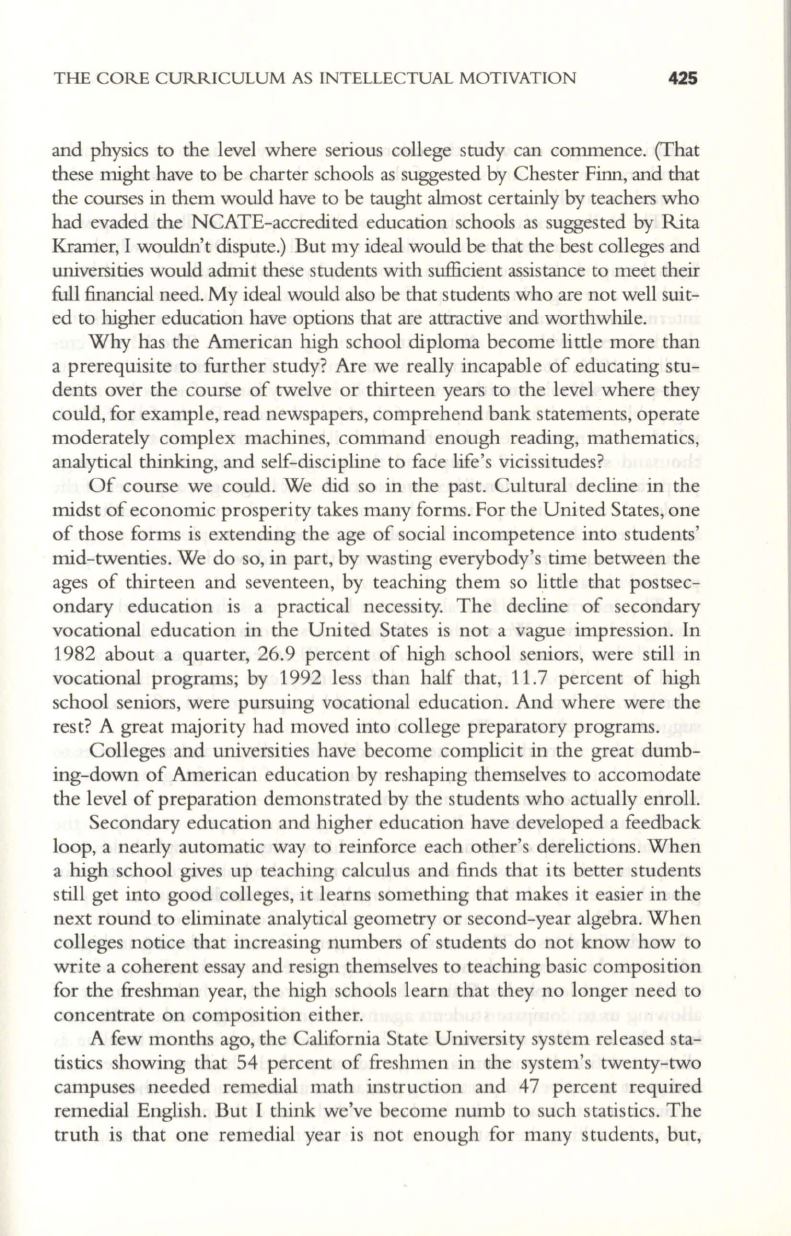
THE CORE CURRICULUM AS INTELLECTUAL MOTIVATION
425
and physics to the level where serious college study can commence. (That
these might have to be charter schools as sugges ted by Ches ter Finn, and that
the courses in them would have to be taught almost certainly by teachers who
had evaded the NCATE-accredited education schools as suggested by Rita
Kramer, I wouldn't dispute.) But my ideal would be that the best colleges and
universities would admit these students with sufficient assistance to meet their
full financial need. My ideal would also be that students who are not well suit–
ed to higher education have options that are attractive and worthwhile.
Why has the American high school diploma become litde more than
a prerequisite to further study? Are we really incapable of educating stu–
dents over the course of twelve or thirteen years to the level where they
could, for example, read newspapers, comprehend bank statements, operate
moderately complex machines, command enough reading, mathematics,
analytical thinking, and self-disci pline to face life's vicissitudes?
Of course we could. We did so in the past. Cultural decline in the
midst of economic prosperity takes many forms. For the United States, one
of those forms is extending the age of social incompetence into students'
mid-twenties. We do so, in part, by wasting everybody's time between the
ages of thirteen and seventeen, by teaching them so litde that postsec–
ondary education is a practical necessity. The decline of secondary
vocational education in the United States is not a vague impression.
In
1982 about a quarter, 26.9 percent of high school seniors, were still in
vocational programs; by 1992 less than half that,ll. 7 percent of high
school seniors, were pursuing vocational education. And where were the
rest? A great majority had moved into college preparatory programs.
Colleges and universi ties have become complici t in the great dumb–
ing-down of American education by reshaping themselves to accomodate
the level of preparation demonstrated by the students who actually enroll.
Secondary education and higher education have developed a feedback
loop, a nearly automatic way to reinforce each other's derelictions. When
a high school gives up teaching calculus and finds that its better students
still get into good colleges, it learns something that makes it easier in the
next round to eliminate analytical geometry or second-year algebra. When
colleges notice that increasing numbers of students do not know how to
write a coherent essay and resign themselves to teaching basic composition
for the freshman year, the high schools learn that they no longer need to
concentrate on composi tion ei ther.
A few months ago, the California State University system released sta–
tistics showing that 54 percent of freshmen in the system's twenty-two
campuses needed remedial math instruction and 47 percent required
remedial English. But I think we've become numb to such statistics. The
truth is that one remedial year is not enough for many students, but,


